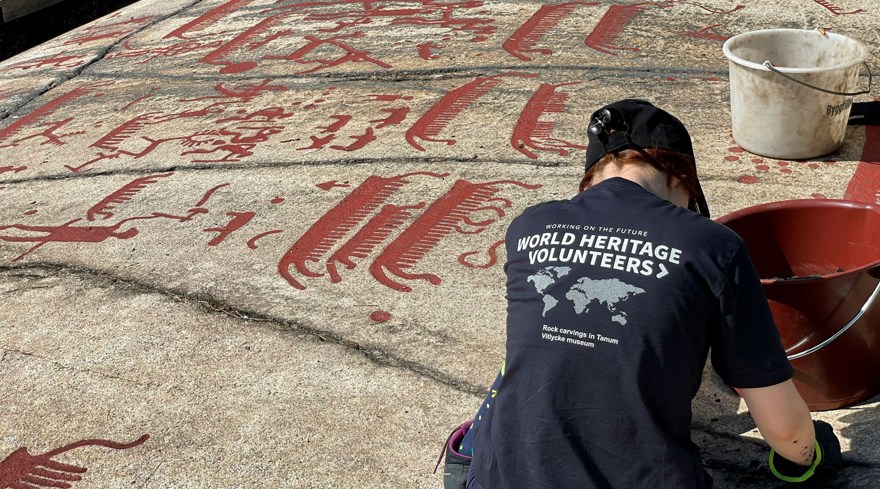Weathering and care

Many of the Bohus county and World Heritage rock carvings are disappearing slowly because the rocks they are made on are crumbling. Why do the rocks decay, and what can be done about it? How can the images be saved for our descendants?
Bohus granite
The Bohus granite in Tanum was formed around 900 million years ago. Tectonic movements forced the older rock types to melt further down in the earth's crust where they formed magma. When the magma cooled again, it solidified at a depth of 10km into rock with different colours, hardness and mineral grain size. To some extent this depended on how quickly the cooling took place. Stone masons are well aware of the varying properties of granite and can select granite with a specific colour which is softer and easier to work. Perhaps the rock carvers thought in the same way?
Weathering
During the last 900 million years, 10 kilometres of rock have been eroded to expose the current surface. During warm periods with very high "air pollution" from volcanic eruptions, this erosion accelerated. During the last ice age, all the old weathered rock was worn away and the withdrawing ice left softly sculpted slabs of stone. As a result, Bronze Age people were able to chisel their figures into the rounded rocks with their smooth surfaces.
But as soon as the rocks rose above the sea, erosion started. The more easily weathered minerals in the granite began to dissolve in the rainwater, which is naturally acidic. The acidity in the atmosphere is controlled through this process! Another interesting aspect of weathering is that all substances in the food chain, except nitrogen, were originally dissolved from rocks. When the surface became more porous, plants could gain a foothold – which further accelerated erosion. In some places erosion has now reached a critical limit, with low strength and pieces loosening every winter when the water freezes and expands in the surface pores.
Cleaning
Within the World Heritage Site, rock carvings are kept clear of branches, leaves, grass, moss, earth and microbial growth such as lichens, algae and bacteria. The purpose of cleaning is firstly so that visitors are able to see the carvings and secondly to reduce the erosion of the rocks. Tree roots can cause a lot of damage if they grow in cracks and split parts of the rock, but other types of organic growth may be less harmful than the method used to clean them off the rock.
As a part of World Heritage Site management, cleaning methods are being developed which do not harm the rock, people or the environment, but which are still effective. Which method chosen is also a question of cost, of course. There may also be different views as to how "clean" a rock should be. What do you think?
Mechanical cleaning
The most obvious form of cleaning is to brush off every rock once a year or more. It is a form of mechanical cleaning like other methods, such as scrubbing the rocks with water and a soft scrubbing brush. In some cases lichens are scraped off the figures using a stick when documenting or re-painting the carvings. A wooden stick is softer than the rock and is sufficiently gentle as a method of cleaning.
Chemical cleaning
There are many commercially available products to kill micro-organisms on stone or wood. When it comes to cleaning surfaces with rock carvings, the selection is more limited. This is because we cannot use anything that produces salts, or which has a high or low pH. At the moment ethanol is being tried out as a cleaner for rocks along the Vitlycke Path. The alcohol is sprayed on to kill lichens and algae by drying them out and dissolving the cell membranes. It is harmless for the rocks and for staff, and is also inexpensive. The trials are promising and the method will be used for more rocks.
Covering
One effective and gentle method of cleaning is to cover the rock with an opaque material during the winter. Lichens and algae cannot grow when they do not get any light. The cover also preserves the red paint much longer than if the surface is left open all round the year. If covering is combined with an insulating material, it results in the most effective method we have to date for reducing the decay of the rocks.
The method is very useful, but some think it is a shame that we cannot see the carvings while they are covered. It also has the disadvantage of being a rather expensive method, since it is labour intensive. A trial is currently in progress at Aspeberget where a cover has been made with an image of rock carving printed on it in a life-size scale. It is possible that more rock carvings at the World Heritage Site will be covered in this way in the future.
Eva Ernfridsson, MSc in stone restoring, MSc in biology.






